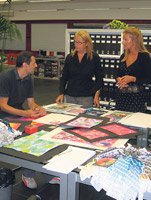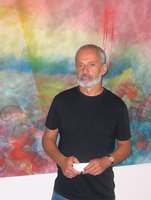Exporting Italian Style
California is a small but intriguing market for many of Italy’s textile makers.
Picturesque Como is minutes from the Swiss border and while it is well-known for its beautiful lake, exclusive resorts and celebrity residents, it is also one of Italy’s textile centers. The textile mills are located in the province of Como, outside the city of Como’s limits and about 30 miles north of Milan.
In the lead-up to the Los Angeles International Textile Show, the California Apparel News caught up with a few of Como’s textile makers to discuss each company’s specialty and where the West Coast market fits into its business plans.
Tessitura Taiana Virgilio Year founded: 19330 Specialty: Woven shirting fabrics in stretch and non-stretch; stretch wovens for the swimwear market U.S. contact: Jose Gonzales (818) 906-0736
Taiana was founded in 1933 by the Taiana family. These days, the company is run by the second generation, headed by Claudio Taiana, who oversees 50 employees working within the company’s 6,000-square-meter facility in Como, as well as an additional 70 employees working outside the Como plant.
The company produces shirting fabrics and swim textiles in its own facilities and converts greige goods for more basic items.
“We are a compact company, but we are proud because we follow every operation step by step,” said Taiana.
Taiana’s largest market is Italy and the company’s fabrics appear in lines of large brands such as Benetton, as well as the diffusion lines of labels such as Armani, Missoni, Versace and Roberto Cavalli. Outside of Italy, the company’s best markets are Spain and England.
The company began selling to the United States in 1990 and soon broke into the West Coast’s swimwear market. After a strong start, Taiana’s West Coast swim business has settled to about 15 percent of its business overall.
“The main reason is a lot of West Coast companies moved production to China,” Taiana said. “If the manufacturer is in Europe or Mexico, it’s still affordable to buy European fabrics because we are not in direct competition with China. If you go to China, they usually provide you with full-package production.”
Taiana said the company saw the same thing happen to its shirting business, which is now about 15 percent in the United States. “Before it was more when the China effect was not evident. China impacted the U.S. market more than any other market.”
The company is finding success with California’s contemporary manufacturers and designers such as Louis Verdad, BCBG Max Azria and Eva Franco. Taiana is also finding new opportunities with premiumdenim makers like 7 for All Mankind.
“The jeans-wear people are looking for something in shirtings that is more complete than a simple T-shirt,” Taiana said.
The company is also looking to India as a possible avenue for growth and recently met with Varanasi, India–based Fabco to discuss producing a secondary textile collection in India. Taiana said he will likely produce a shirting line in India rather than swimwear fabrics because India cannot yet meet Taiana’s quality standards for technical fabrics. Instead, the company is looking to produce silk and cotton shirtings in India and possibly sell their fabrics to the Indian market.
Guest S.p.A. Year founded: 2001 as a division of 80-year-old Clerici Tessuto & C. S.p.A. Specialty: Coordinating prints and patterns on wovens and knits U.S. contact: Valeria Asano (212) 808-4030
Guest S.p.A. was founded five year ago as a new, more moderately priced division of 80-year-old textile mill Clerici Tessuto, producer for high-end apparel makers such as Chanel and Prada.
Cristina Curti is the general manager of the Guest division, which seeks to closely follow high-end trends but produce it for a broader market.
“We try to give customers a good collection with good quality and a good price,” she said, noting that the 13-member Guest staff has access to Clerici Tessuto’s massive archive.
Guest’s specialty is coordinating fabrics in wool, silk, rayon and acetate. Although not every customer takes advantage of the collection’s coordinating prints, Curti said it helps them focus on the look that is right for their own apparel line.
“For us, the key is the customer’s choice,” she said. “Some customers want to see what we present and then they can construct their own collection.”
Curti and her team have a separate office and showroom, but the company shares production, quality control and warehousing with Clerici Tessuto’s other lines. The facility has the ability to produce screen-printed fabrics by machine and by hand, as well as inkject prints.
Curti joined Guest nearly three years ago. The company’s primary market is Italy, but it also sells to apparel makers in France, the United Kingdom, Spain and Germany. Curti said she has a “nice but not fabulous business” with American apparel makers based on the East Coast. While California is not a large portion of Guest’s business, Curti said she sees potential for it to grow.
“Eventually we believe it will be important; now it is only 10 percent,” she said. “We love the West Coast, we love the customers on the West Coast.”
Textilprint by Betex Srl. Year founded: 1976 Specialty: Coordinating prints for swimwear U.S. contact: Gera Gallico, Vinci & Co., (212) 997-9249
Textilprint got its start producing swimwear textile in Italy back in 1976. The company still produces its original coordinating swim prints in Italy, but it also produces in China and in the United States and is looking to add Turkey to its mix.
“We follow the trend but follow it in a way that has to be commercial for the swim business,” said founder Saby Fresko.
Textilprint’s facility is based in Cirimido, in the Como region. The company employs 28 people in the office and showroom, including seven on the design staff. Textilprint has 90 employees working in the Italian print mill, in which it shares a 50 percent ownership stake with sister textile maker Luciantex by MC. Although Luciantex produces fabrics for swimwear and lingerie, the majority of its line is for the sportswear market.
Textilprint’s fabrics appear in the swim collections of labels such as Calvin Klein, Gideon Oberson, Gottex and Anne Cole. They also do custom printing for companies such as Tommy Hilfiger and Coach.
And while swimwear is the bulk of Textilprint’s business, it is starting to work with lingerie companies as well. Many of the large companies such as Victoria’s Secret opt to split production between Italy and China, reserving the large-volume production for China.
“The American market was always important for us, but two years ago it became more difficult,” said Fresko, who said that at the time the U.S. market dropped from 50 percent of Textilprint’s business to about 25 percent.
That’s when Textilprint opened its print facility in China. The latest print facility opened recently in New Jersey. For large manufacturers with multiple lines, the three locations provide flexibility, Fresko said.
For example, he explained, Warnaco may print Anne Cole Studio in Italy but the rest in New Jersey. Its Speedo collection is typically produced in the United States.
The number of converters in the United States has dwindled in recent years, Fresko said, noting that there are only two that he considers competitors. “There is room for us to enter the market.”
In the United States, Textilprint is represented by Gera Gallico, of New York–based Vinci & Co. Fresko said he is looking to hireWest Coast representation to work directly with California companies and report back to Gallico. “On the West Coast, we have customers, but it is marginal because when they need us we are not there,” he said.
Fresko said he is also looking to hire an East Coast and a West Coast designer to work closely with the American market and interpret the trends for the U.S. market. “We have the identity in the U.S. of having the Italian touch,” he said.
























